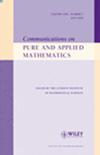玻尔兹曼理论中的幽灵效应
IF 2.7
1区 数学
Q1 MATHEMATICS
引用次数: 0
摘要
在给定壁面温度分布的气体中自然发生的“幽灵效应”,在这样一个经典的物理问题中,表现出一种罕见的动力学效应,超出了经典流体理论和傅立叶定律的预测。当Knudsen数趋于零时,体内温度的有限变化由一个无限小的鬼影状速度场决定,该速度场由麦克斯韦滑移边界条件预测的切向壁温度的给定有限变化所产生。在数学上,这种有限的变化导致在基本能量估计中存在严重的奇点和克努森层近似。这两种困难都不是现有的一般三维有界域稳定玻尔兹曼方程的偏微分方程理论所能达到的。因此,尽管早在20世纪60年代就发现了温度变化的幽灵效应,但其数学有效性一直是一个具有挑战性和耐人寻味的开放性问题,引起了困惑和怀疑。如果温度变化是小而有限的,我们肯定地解决了这一开放性问题,通过开发一个新的框架,主要创新如下:(1)key - Hodge分解及其相应的局部守恒律消除了严重的体积奇点,导致能量估计降低;(2)通过动量守恒的惊人增益和对偶Stokes解;(3)守恒、能量守恒和耦合对偶Stokes-Poisson解约化为边界奇点;(4)截断边界层的关键构造通过新的Hardy和BV估计消除了这种边界奇点。本文章由计算机程序翻译,如有差异,请以英文原文为准。
Ghost effect from Boltzmann theory
Taking place naturally in a gas subject to a given wall temperature distribution, the “ghost effect” exhibits a rare kinetic effect beyond the prediction of classical fluid theory and Fourier law in such a classical problem in physics. As the Knudsen number goes to zero, the finite variation of temperature in the bulk is determined by an infinitesimal, ghost‐like velocity field, created by a given finite variation of the tangential wall temperature as predicted by Maxwell's slip boundary condition. Mathematically, such a finite variation leads to the presence of a severe singularity and a Knudsen layer approximation in the fundamental energy estimate. Neither difficulty is within the reach of any existing PDE theory on the steady Boltzmann equation in a general 3D bounded domain. Consequently, in spite of the discovery of such a ghost effect from temperature variation in as early as 1960s, its mathematical validity has been a challenging and intriguing open question, causing confusion and suspicion. We settle this open question in affirmative if the temperature variation is small but finite, by developing a new framework with four major innovations as follows: (1) a key ‐Hodge decomposition and its corresponding local ‐conservation law eliminate the severe bulk singularity, leading to a reduced energy estimate; (2) a surprising gain in via momentum conservation and a dual Stokes solution; (3) the ‐conservation, energy conservation, and a coupled dual Stokes–Poisson solution reduces to an boundary singularity; (4) a crucial construction of ‐cutoff boundary layer eliminates such boundary singularity via new Hardy's and BV estimates.
求助全文
通过发布文献求助,成功后即可免费获取论文全文。
去求助
来源期刊
CiteScore
6.70
自引率
3.30%
发文量
59
审稿时长
>12 weeks
期刊介绍:
Communications on Pure and Applied Mathematics (ISSN 0010-3640) is published monthly, one volume per year, by John Wiley & Sons, Inc. © 2019.
The journal primarily publishes papers originating at or solicited by the Courant Institute of Mathematical Sciences. It features recent developments in applied mathematics, mathematical physics, and mathematical analysis. The topics include partial differential equations, computer science, and applied mathematics. CPAM is devoted to mathematical contributions to the sciences; both theoretical and applied papers, of original or expository type, are included.

 求助内容:
求助内容: 应助结果提醒方式:
应助结果提醒方式:


